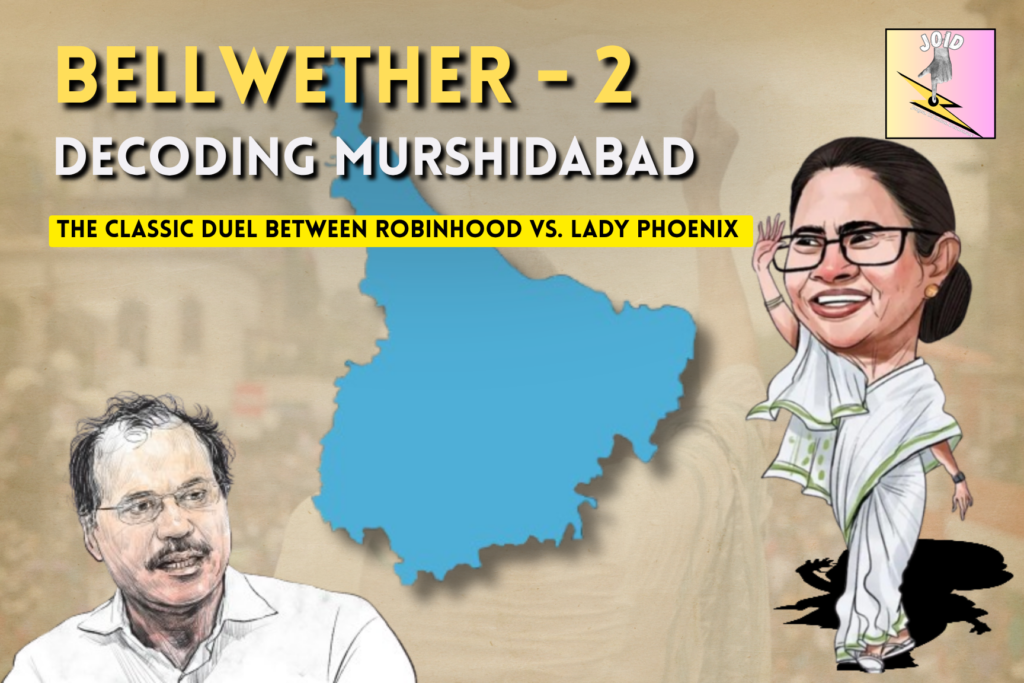
“At least Chowdhury learned his lessons, He troubled a lot to our Raja babu. I am from Kandi. I know what it means, his defeat is”- Anonymous
While visiting the West Bengal Legislative Assembly as a delegate for the first time in 2024, I heard from an individual who expressed a pathological hatred for Adhir Chowdhury. As is common in traditional Congress culture, there is loyalty to one leader and disloyalty to another, even when they come from the same region. This gentleman was voicing his feelings about the recent Lok Sabha election results, where Chowdhury was decisively defeated for the first time in his political career by AITC candidate and former cricketer Yusuf Pathan. His sentiment did not reflect support for AITC or enthusiasm for Mamata Banerjee; rather, it portrayed a sense of revenge and grief. During his rise to power in the INC at the beginning of the millennial era, Chowdhury started to undermine local INC leadership in four districts of North-Central Bengal, prominently known as Gour Banga. These were significant figures whom even the top INC leadership respected. Atish Singha, the Raja Babu of Kandi, was his primary rival in this struggle. In 2006, a well-known byline in a popular Bengali newspaper coined the battle between Adhir Chowdhury and Atish Singha as the battle of Raja Babu versus Robin Hood. Like the visual retreat in the Battle of Bustards (ref: GOT), Adhir’s faction conceded defeat. This was a shocking turn of events for Bengali Vadrolok politics. Then-CM Buddhadev Bhattacharya marked this defeat of Rajababu as a significant loss of political balance in his maiden statement of that session. Despite his allegiance spanning 360 degrees from different political standpoints, former CM Buddhadev Bhattacharya was a staunch critic of Adhir Chowdhury and his political realm. When the baton was passed to Mamata Banerjee, the scenario remained unchanged. Adhir Chowdhury was not willing to bow down, even though the INC was Mamata Banerjee’s ally. This continued for 13 years. Over time, Adhir Chowdhury became PCC President, a five-time MP, and leader of the Congress Legislative Party in the Lower House, while Mamata Banerjee secured her third term in 2021 with a two-thirds majority in a house with no representation from the INC or the Left Front. In the contemporary political landscape, this can be described as drastic and classical. Despite her acquisition of all INC and Congress-minded forces, Mamata Banerjee was unable to defeat Adhir. Ultimately, his loss marked the end of this episode and a chapter in their rivalry. Even until the end, Chowdhury consistently sought to cause discomfort. The bye-election in Sagardighi stands as one of the most significant examples. After nearly ten years, an incumbent party lost the election to a force ranked third or fourth in cumulative power. Despite being intimidated and advised by a seasoned and highly promoted Action Committee, this defeat was alarming. A pseudo-oligarch backed by Chowdhury won this election with utter confidence. Aside from the fringe successes in Taherpur, Jhalda, and Bhangar, Sagardighi became a noteworthy chapter for opposition forces in West Bengal politics. The Bengali media commonly referred to this as the Sagardighi Model.
The Sagardighi model served as a homage to the arrogance perpetuated by the Quasi Power Eco-System, which remains relevant in the current political powerhouse of West Bengal. The idea of ignoring ethics and rules was curtailed by a potential mandate. However, this was again violated with the poaching of the incumbent MLA, Bairon Biswas, from the INC to the AITC. In a quintessential manner of endorsing non-democratic practices, Bairon shifted from the INC to the AITC. With this event at the core, the decline of Adhir Chowdhury began to unfold. Whether that is one aspect of this grandeur, the other aspect is quite alarming, as it is evident that political poaching has become a normal occurrence in Indian politics. The rise of a consultancy approach to support political activities since 2011 has witnessed a new trend where a typical sales approach to achieve targets has become the new normal. This took a drastic turn after 2019, following the second-term win of PM Modi and the subsequent impact of COVID-19. Earlier, activities were limited to campaigning, branding, and strategizing. After 2014, intelligence and organizational capacity building began to take center stage. Consulting agencies started to establish units known as Political Intelligence Units (PIUs), becoming central to these deliverables. Political joining, aka poaching, became one of the core tasks of this exercise, with the necessary exchange of time. Otherwise, campaign designing companies like JWT, IPAN, Crayons, and Percept were largely engaged in different methods and practices.
This can often be identified as the campaign era of pre-Modi, where stalwarts like Leo Burnett and Rajiv Desai were primarily responsible for developing a solid base for the Indian National Congress. Immediate examples include NDA’s “India Shining” versus INC’s “Aam Aadmi Ka Sipahi.” “Jai Ho” and “Bharat Nirman” are other significant campaigns that resonated during this period. This momentum began to unravel with the rise of Modi and Kejriwal, which defined a presidential-style campaign disclosure. Mostly practiced in American politics, this trend was relatively new in the context of Indian political upheaval. The trend indicates extensive involvement of potential political and apolitical stakeholders in political parties. The continuity of this phenomenon became a ritual in 2019 when both AITC and BJP started to initiate this joining from various personalities as “Influencers.” From a personal standpoint, this marks the end of political morality and ideology, presenting a drastic deviation. Historically, this has often been observed as a workaround. Since the 20th century, when dual political membership was a common practice, and even earlier, during socio-religious campaigns when conversion was readily facilitated, it appears that beliefs and ideologies constantly evolve with the changing dynamics of society. However, how this connects with political bandwidth remains a fundamental question, as it defines an individual’s core standpoint and their choice of a political position. With this as a whole, it seems Adhir Chowdhury’s ideological quotient is stronger than many of his contemporaries. But that might not be the complete narrative, as Adhir himself shifted his stance twice. First being known to be a Naxalbari sympathizer, then being a part of contemporary stalwart Jatin Chowdhury. He chose to take a different route in Bengal politics, which can be coined as a “rebel”. Perhaps two names can be echoed with this of his individualistic approach: Subhash Chakraborty and Saifuddin Chowdhury. If we can observe the three of them in their political journey, then the offer of democratic socialism was central from their end, which eventually operates as an antithesis to Mamta Banerjee’s anarchic liberal democracy. This route was often mastered by Arvind Kejriwal while incepting India’s best political upstart project called Aam Aadmi Party (AAP).
When comparing the two models, a key aspect to consider is the utility of anger. In its first 10 years of survival, the Trinamool Congress (TMC) mastered the ability to capitalize on that anger from its urban-semi urban lower middle-class voter base. From their iconic 21st July march to Operation Sunshine, the urban subaltern voter base was the core capital for TMC. At that time, the organization-wise INC was contesting against the CPI(M)-led Left Front across Bengal. After the 2006 election, when a Public-Mandate Consulting platform shared a consolidated report with Mamata Banerjee, it indicated that AITC needed to master the rural voter base, particularly in relation to its connections with Muslim and women voters. This marked the beginning of TMC and Mamata Banerjee’s secular quest. It eventually started to integrate the INC organogram into the TMC structure, with several old-guard members from INC being brought in before the 2009 Loksabha election. In 2011, when TMC won its first state election, the INC had minimal organizational weight, especially in the Junglemahal and Gour Banga regions. Aside from North Bengal, specifically from Chicken Neck to Alipurduar, the rest of the organizational strength began to erode over the next five years. Meanwhile, TMC transformed into AITC, gained recognition as a national party, and was then limited to a state party within five years. The crisis of irrelevance for INC was a constant issue, which recently took a new turn with Shankar Malakar joining AITC in 2025. In adopting the Congress political system, Mamata Banerjee excelled in building organizational capacity, something that was commonly lacking in INC. In AITC/TMC’s case, the mother unit began to evolve into a quasi-governmental avenue. Each local office has a computer setup, the structure has sound scrutiny, and other ecosystems are automatically built. The adoption of INC’s organogram and CPI(M)/Left organizational capacity is a key factor in AITC/TMC’s survival as an independent political voice. Despite being regarded as an indiscipline political force, Mamata Banerjee expertly weaves her political ecosystem. She understood that anger is not a resource that can be supported indefinitely; a solid, systematic quasi-bureaucratic structure is essential. Despite this track record, AITC is limited to below a 45% mandate in West Bengal. In most of the Party’s dominance, it still has a hold in several regions. The cases of Bahrampur, Sagardighi, and Bharatpur are some of the statistics. Pre-2025, Murshidabad faced riots, and the core political bandwidth, which was earlier in favor of AITC, is mostly predicted to swing. With the riots and drastic power shifts in Bangladesh in the post-electoral setup, Murshidabad could play against AITC’s core campaign in the region. In 2011, winning Murshidabad and Birbhum were two significant successes for AITC. In 2026, retaining these two regions will be considered a potential achievement, as the Party has potential dents and the district has a history of being inclined toward anger. Historically speaking, Murshidabad has always set trends that dictate the endgame in Bengal’s political history. Taking inspiration from that, understanding what is coming next would be important to conceive the political and social endgame that could arise for Bengal. In his book (The Backstage of Democracy), Oxford Graduate Amogh Dhar Sharma mentioned how Computer and Scientific Intelligence have become core components in supporting Indian Democratic and Political Contenders in the long run. Starting with PM Indira Gandhi, referred to as the Human-Computer, to Rajiv Gandhi’s Computer Boys (a group of technocratic aspirants led by Sam Pitroda). This analogy illustrates how, in the context of Bengal, the idea of organizational capacity was developed under Mamata Banerjee. As theorist Partha Chatterjee and Social Theorist Rajni Kothari stated about the Political System (1st Congress Political System/State and Politics in India), Mamata Banerjee replicates the model of building last-mile party establishments along with technological facilities. The Computerization of a Political System, or the Trinamool Congress System with Computer, might be identified as a unique core that Mamta Banerjee evolved for 2+ decades whether to grow the Party. With this as a journey, it seems the 4 core components of Compatibility: Politics, Development, Corruption, and Communalism become the hinge points for the voter mindset in Political and Party Society in West Bengal. On one side, Mamata becomes the champion of this, while Chowdhury has been limited to a regional aspiration for the last 20 years. In 2021, the Trinamool Party introduced a new position in the District Unit called District Coordinator, which was also designed for the Assembly Level. The question is, while this was inspired by Rajiv Gandhi’s design for INC in 1984, YSRCP’s design adopted in 2017 raises an egg/chicken question. Additionally, many of our interpretations of democracy are limited to a bipartisan lens, which does not provide much opportunity to study the Organizational Capacity and Voter Psyche analysis of Ambedkarite Parties, Left Parties, Socialist Parties, and Peasant Political Forces. This is another gap in the practice of Political Theory and Contemporary Knowledge Analysis in our country. They are significant because from 1991 to 2024, the Ideological Diaspora, other than INC and Congress, has been dominated by these Political Forces. The 2024 Election exemplifies this experience, where, except for 340+ seats, with BJP having 240 and INC having 99, the remaining 130+ seats are dominated by Parties known for their Politics on Identity, Class, Peasantry, and Culture. These 130 seats and their representation actually create a larger playing field for Indian Multi-Party and First-Past-the-Post designed Democratic Aspirations. In one way, both characters in this writing experience belong to that cohort.
End Note: The swing factor and political dominance emerge as critical variables in assessing the trajectories of two political figures who, despite originating from the same ideological tradition, have followed markedly divergent paths. While one has maintained prolonged influence and institutional continuity, the other has experienced a more fragmented and oppositional form of engagement.
In his seminal analysis of Ashis Nandy, scholar, and political theorist Ramin Jahanbegloo repeatedly employs the term “gadfly”—a choice that is neither incidental nor rhetorical. Rather, it functions as a deliberate conceptual frame, encapsulating Nandy’s role as a dissenter who persistently challenged dominant paradigms from within the intellectual and political mainstream.
When viewed through this lens, the juxtaposition of these two figures reveals a significant contradiction in character and political function. Despite their common origins, their respective trajectories underscore different modes of political existence: one as a figure of continuity and electoral durability, the other as an intermittent yet potentially catalytic presence.
From a predictive standpoint, the implications are clear. For the first, an occasional electoral loss may not undermine their political relevance, as their influence is embedded within a broader, enduring structure. For the second, however, any disruption, such as a break in electoral success, carries the risk of marginalization, thereby framing them as a volatile but strategically significant actor within the political landscape.
Post Script: Political contests, particularly in postcolonial democracies like India, are best understood as part of an extended and evolving struggle. As scholars such as Samuel Huntington and others have noted, politics in such contexts is less about linear progression and more about cycles of mobilization, consolidation, and contestation. Electoral politics, in this framework, becomes what many have termed the art of probability—a space where patterns are discernible, but outcomes remain contingent. Hence, offering conclusive commentary on electoral dynamics requires careful navigation of both historical precedents and emergent tendencies.
In this light, while current indicators may not favor Chowdhury, the possibility of a reversal by 2026 should not be discounted. Political momentum is often nonlinear, and public sentiment can shift rapidly in response to broader socio-economic stimuli or internal party realignments. The All India Trinamool Congress’s (AITC) dominant position in Murshidabad, for instance, must be analyzed through the lens of populist governance—a strategy that Ernesto Laclau describes as constructing a political identity by articulating popular demands in a unifying narrative. AITC’s welfare-driven populism has enabled it to create a durable yet fluid coalition of support, particularly in regions with a history of economic marginalization.
Two developments are particularly instructive in this context. First, AITC’s recent win in the Bhogobangola by-election in 2024. Second, the earlier appointment of Suvendu Adhikari—now LOP —as the party-in-charge of Murshidabad during his tenure with AITC. These events signify not only internal shifts within the party but also the region’s strategic importance as a site of electoral volatility and potential realignment.
As political behavior theorists argue, regions marked by high levels of political competition—such as Murshidabad, Nadia, and Birbhum—often function as bellwethers in larger electoral patterns. Their capacity to swing decisively can recalibrate the state’s political equilibrium. Thus, in moments of closely contested mandates, these districts may emerge as critical terrain in shaping the tone and direction of West Bengal’s political landscape heading into 2026.
References:
A. Ashish Nandy and Ananya Vajpeyi – A Life in Dissent_Ramin Jahanbegloo ( You can buy the book clicking on the title link here )
B. The Backstage of Democracy – Amogh Dhar Sharma ( You can buy the book clicking on the title link here )
C. The Backstage of Democracy Podcast – Ft. Amogh Dhar Sharma
D. Banglasphere Podcast – Ft. Adhir Chowdhury and Suman Chatterjee
E. Society and Politics – Partha Chatterjee
F. The Congress System in India Kothari, Rajni. “The Congress ‘System’ in India.” Asian Survey, vol. 4, no. 12, 1964, pp. 1161–73. JSTOR,
G. Parties without partisans: Political change in advanced industrial democracies. Dalton, R. J., & Wattenberg, M. P. (2000). Oxford University Press.
H. Political order in changing societies. Huntington, S. P. (1968). Yale University Press. ( You can buy the book clicking on the title link here )
I. Southern politics in state and nation. Key, V. O. (1949). Alfred A. Knopf.
J. On populist reason. Verso. Laclau, E. (2005). ( You can buy the book clicking on the title link here )
Our other articles : Bengal Bellwether – 1 | India United – India’s message is loud & clear on terrorism a diplomatic strike on terror| The Indian Stock Market is bleeding | SUPER NARI – 25 | Caste and the Ballot in Bihar | The suicidal mission of Pakistan’s so called ‘Establishment’ | Who is Responsible for Bihar’s Migration Crisis? | Why Congress must go solo in Bihar | Jai Bhim | Old is Gold , Resurrection of ‘Dynasty Politics’ | China Faces 125% Tariff by USA: A Strategic Opportunity for India | When the Accuser Becomes the Accused

Ishan Banerjee is an experienced professional serving as a mid-level manager and consultant portfolio. Over 10 years, he has worked in over 70+ districts across 8 states in the eastern, western and northeastern region of India, including Bihar, Jharkhand, Odisha, Chattisgarh , and West Bengal. He has also worked in diverse locations such as Punjab and Meghalaya. His areas of expertise include program management, data analysis, stakeholder liaison, research and development, program design, and program monitoring and evaluation.
